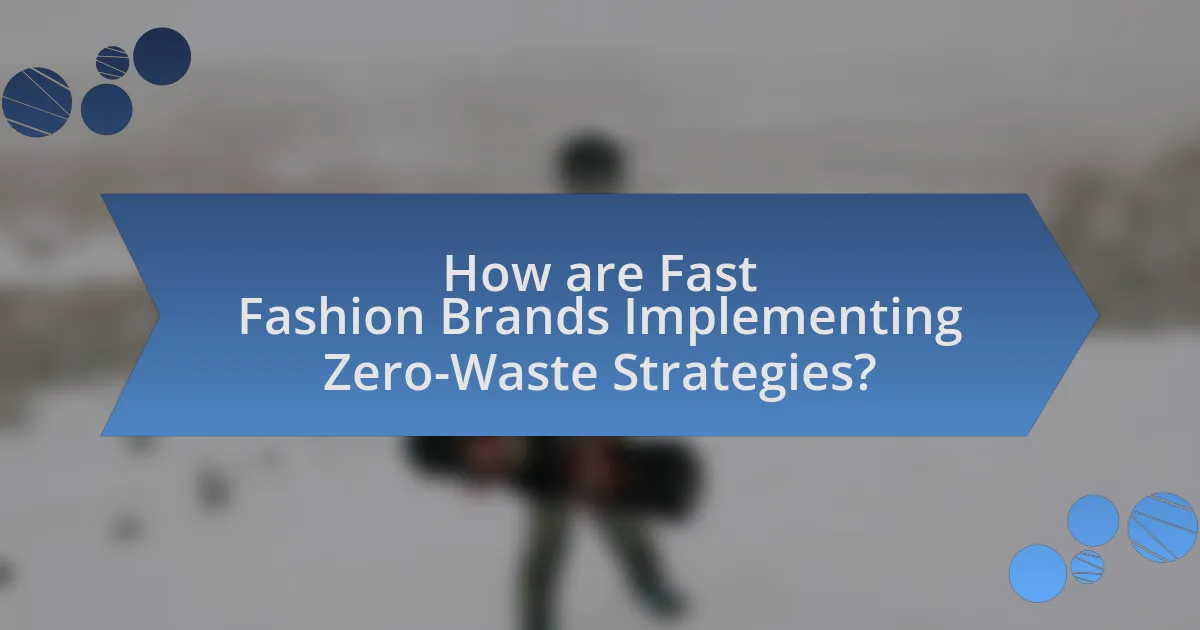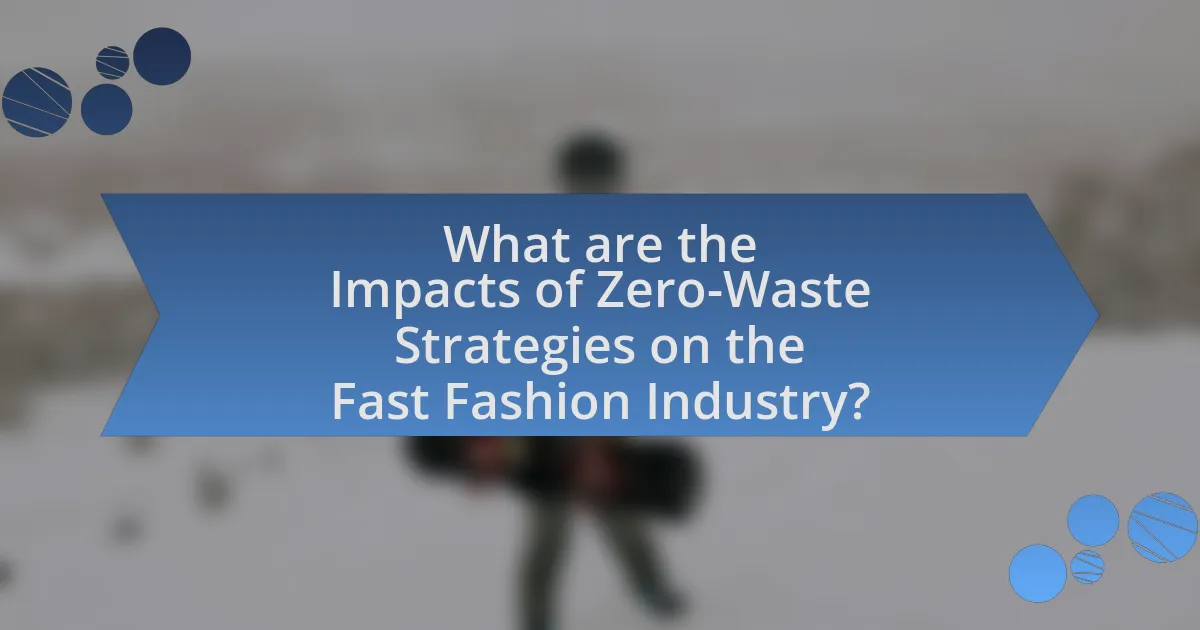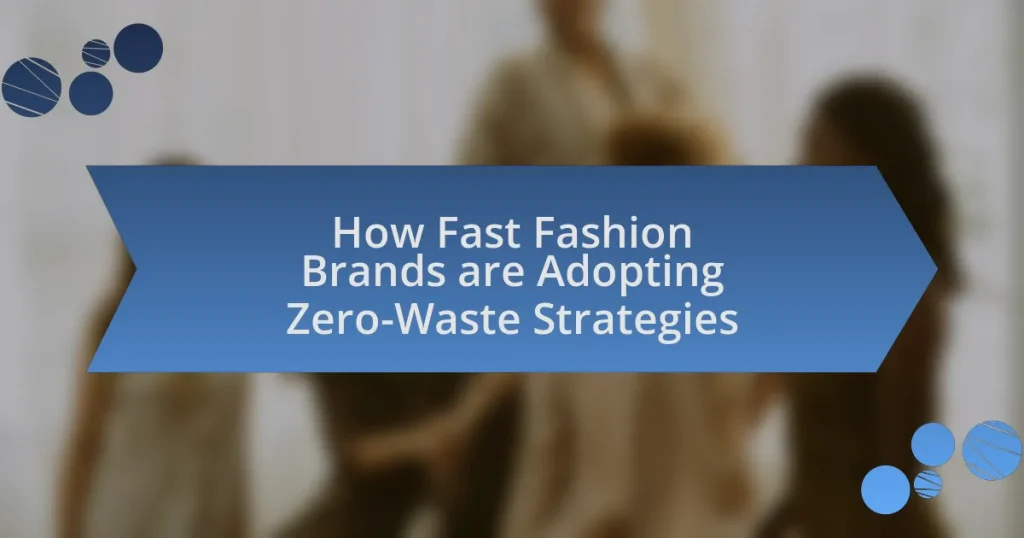Fast fashion brands are increasingly adopting zero-waste strategies to minimize textile waste throughout their production and consumption processes. These strategies include designing garments that utilize every part of the fabric, implementing recycling initiatives, and employing digital technologies to optimize material use. Key principles of zero-waste focus on waste prevention, resource efficiency, and sustainable design, which collectively aim to create a circular economy. The article explores how brands like H&M and Zara are leading the way in these initiatives, the challenges they face, and the economic and environmental benefits of transitioning to zero-waste practices. Additionally, it highlights the impact of consumer demand on the evolution of these strategies and the innovative practices emerging in the fast fashion industry.

What are Zero-Waste Strategies in Fast Fashion?
Zero-waste strategies in fast fashion aim to eliminate textile waste throughout the production and consumption processes. These strategies include designing garments that utilize every part of the fabric, implementing take-back programs for recycling old clothing, and using digital technologies to optimize cutting patterns, thereby reducing leftover materials. For instance, brands like Reformation and Eileen Fisher have adopted these practices, demonstrating a commitment to sustainability by minimizing landfill contributions and promoting circular fashion.
How do Zero-Waste Strategies differ from traditional fashion practices?
Zero-Waste Strategies differ from traditional fashion practices by prioritizing the elimination of textile waste throughout the entire production process. Traditional fashion often relies on linear models that generate significant waste, with an estimated 92 million tons of textile waste produced globally each year, according to the United Nations. In contrast, Zero-Waste Strategies focus on designing garments in a way that utilizes every part of the fabric, often employing techniques such as pattern-making that maximizes material use and encourages recycling or upcycling of leftover materials. This approach not only reduces environmental impact but also promotes sustainable consumption practices, aligning with the growing demand for eco-friendly solutions in the fashion industry.
What are the key principles of Zero-Waste Strategies?
The key principles of Zero-Waste Strategies include waste prevention, resource efficiency, and sustainable design. Waste prevention focuses on reducing the amount of waste generated at the source, emphasizing the importance of minimizing consumption and maximizing the lifespan of products. Resource efficiency involves optimizing the use of materials and energy throughout the production process to reduce environmental impact. Sustainable design incorporates eco-friendly materials and processes, ensuring that products can be reused, recycled, or composted at the end of their life cycle. These principles collectively aim to create a circular economy, where resources are kept in use for as long as possible, thereby reducing the overall waste generated.
Why is Zero-Waste important for the fashion industry?
Zero-Waste is important for the fashion industry because it significantly reduces environmental impact by minimizing textile waste. The fashion industry is responsible for approximately 92 million tons of waste annually, with a large portion coming from discarded clothing and production scraps. Implementing Zero-Waste strategies allows brands to create garments that utilize every part of the fabric, thereby decreasing landfill contributions and promoting sustainability. This approach not only addresses ecological concerns but also aligns with consumer demand for environmentally responsible practices, as studies show that 66% of consumers are willing to pay more for sustainable brands.
What challenges do fast fashion brands face in adopting Zero-Waste Strategies?
Fast fashion brands face significant challenges in adopting Zero-Waste Strategies, primarily due to their business model that prioritizes rapid production and low costs. This model often leads to overproduction and excess inventory, making it difficult to implement waste reduction practices effectively. Additionally, the lack of infrastructure for recycling and upcycling materials in the fast fashion industry complicates the transition to zero waste. According to a report by the Ellen MacArthur Foundation, the fashion industry generates over 92 million tons of waste annually, highlighting the scale of the challenge. Furthermore, consumer demand for new styles at low prices creates pressure on brands to maintain high turnover rates, which contradicts the principles of sustainability and waste reduction.
How do production processes impact waste generation?
Production processes significantly impact waste generation by determining the efficiency of resource use and the types of materials employed. Inefficient production methods often lead to higher waste outputs, as seen in the fast fashion industry, where rapid manufacturing cycles result in excess fabric and unsold inventory. For instance, a study by the Ellen MacArthur Foundation highlights that the fashion industry generates over 92 million tons of waste annually, largely due to inefficient production practices. By adopting more sustainable production processes, such as using digital design tools and recycling materials, brands can minimize waste generation and contribute to zero-waste strategies.
What are the economic implications of transitioning to Zero-Waste?
Transitioning to Zero-Waste has significant economic implications, primarily by reducing costs associated with waste management and resource procurement. Fast fashion brands that adopt Zero-Waste strategies can lower their operational expenses by minimizing landfill fees and decreasing the need for raw materials, as they focus on recycling and reusing materials. For instance, a study by the Ellen MacArthur Foundation found that transitioning to a circular economy could generate $1 trillion in economic benefits by 2025, highlighting the financial advantages of sustainable practices. Additionally, brands that embrace Zero-Waste can enhance their market competitiveness by appealing to environmentally conscious consumers, potentially increasing sales and brand loyalty.

How are Fast Fashion Brands Implementing Zero-Waste Strategies?
Fast fashion brands are implementing zero-waste strategies by redesigning their production processes to minimize textile waste. For instance, brands like H&M and Zara are utilizing techniques such as pattern optimization and digital fabric printing, which reduce off-cuts and excess material. Additionally, these companies are increasingly adopting recycling initiatives, where unsold or returned garments are repurposed into new products, thereby diverting waste from landfills. According to a 2021 report by the Ellen MacArthur Foundation, the fashion industry could reduce its environmental impact significantly by adopting circular economy principles, which include zero-waste strategies.
What innovative practices are being adopted by fast fashion brands?
Fast fashion brands are adopting innovative practices such as utilizing digital design tools and 3D printing to minimize waste and streamline production processes. These technologies allow brands to create virtual prototypes, reducing the need for physical samples and enabling rapid adjustments based on consumer feedback. Additionally, some brands are implementing circular fashion initiatives, where they design products for longevity and recyclability, thus promoting a zero-waste approach. For instance, companies like H&M have launched garment collection programs that encourage customers to recycle old clothing, further supporting sustainable practices within the fast fashion industry.
How are brands redesigning their supply chains for Zero-Waste?
Brands are redesigning their supply chains for Zero-Waste by implementing circular economy principles, which focus on minimizing waste through sustainable practices. For instance, companies are utilizing recycled materials in production, optimizing manufacturing processes to reduce excess fabric, and establishing take-back programs that encourage customers to return used products for recycling or repurposing. Evidence of this shift can be seen in brands like H&M, which has committed to using 100% recycled or sustainably sourced materials by 2030, and Adidas, which has launched products made from ocean plastic, demonstrating a tangible commitment to reducing waste in their supply chains.
What role does technology play in facilitating Zero-Waste practices?
Technology plays a crucial role in facilitating Zero-Waste practices by enabling efficient resource management and waste reduction. Advanced technologies such as data analytics, artificial intelligence, and blockchain help fast fashion brands optimize their supply chains, minimize material waste, and enhance recycling processes. For instance, data analytics can predict consumer demand more accurately, allowing brands to produce only what is needed, thereby reducing overproduction and excess inventory. Additionally, blockchain technology ensures transparency in sourcing materials, which aids in tracking waste and promoting sustainable practices. These technological advancements contribute to a significant reduction in waste generation, aligning with the principles of Zero-Waste.
Which fast fashion brands are leading the way in Zero-Waste initiatives?
H&M and Zara are leading fast fashion brands in Zero-Waste initiatives. H&M has implemented a garment collecting program, allowing customers to recycle old clothes, and aims to use 100% recycled or sustainably sourced materials by 2030. Zara, part of Inditex, has committed to using 100% sustainable fabrics by 2025 and has introduced a recycling program in stores to minimize waste. Both brands are actively working towards reducing their environmental impact through these initiatives.
What specific strategies have successful brands implemented?
Successful brands have implemented strategies such as utilizing sustainable materials, optimizing supply chains, and adopting circular economy principles. For instance, brands like H&M and Zara have introduced collections made from recycled fabrics and organic cotton, significantly reducing their environmental impact. Additionally, these brands have streamlined their production processes to minimize waste, with H&M reporting a 35% reduction in waste through improved inventory management. Furthermore, initiatives like take-back programs encourage customers to return used garments, allowing brands to recycle materials and promote a circular economy, as evidenced by Levi’s WellThread program, which focuses on sustainable production and end-of-life garment recycling.
How do these brands measure the success of their Zero-Waste efforts?
Brands measure the success of their Zero-Waste efforts primarily through metrics such as waste diversion rates, reduction in landfill contributions, and the percentage of materials recycled or reused. For instance, companies often track the volume of waste generated before and after implementing Zero-Waste initiatives, aiming for a significant decrease in waste sent to landfills. Additionally, brands may assess the effectiveness of their recycling programs by calculating the proportion of materials that are successfully repurposed, with some reporting figures as high as 90% in certain initiatives. These metrics provide concrete evidence of progress and help brands refine their strategies to enhance sustainability.

What are the Impacts of Zero-Waste Strategies on the Fast Fashion Industry?
Zero-waste strategies significantly reduce environmental impacts in the fast fashion industry by minimizing textile waste and promoting sustainable practices. These strategies encourage brands to design products that utilize materials efficiently, leading to a decrease in landfill contributions; for instance, the Ellen MacArthur Foundation reports that the fashion industry generates over 92 million tons of waste annually, much of which could be mitigated through zero-waste initiatives. Additionally, implementing zero-waste practices can enhance brand reputation and consumer loyalty, as consumers increasingly favor environmentally responsible brands. Research indicates that 66% of global consumers are willing to pay more for sustainable products, highlighting the economic benefits of adopting such strategies in fast fashion.
How do Zero-Waste Strategies affect consumer behavior?
Zero-waste strategies significantly influence consumer behavior by promoting sustainable purchasing decisions and encouraging a shift towards environmentally conscious consumption. These strategies often lead consumers to prioritize brands that demonstrate commitment to reducing waste, as evidenced by a 2021 survey indicating that 66% of global consumers are willing to pay more for sustainable brands. Additionally, zero-waste initiatives, such as recycling programs and reusable packaging, foster a sense of responsibility among consumers, motivating them to adopt similar practices in their daily lives. This behavioral change is further supported by research from the Ellen MacArthur Foundation, which highlights that consumers increasingly seek transparency and sustainability in their purchasing choices, thereby driving demand for zero-waste practices in the fast fashion industry.
What are the environmental benefits of adopting Zero-Waste practices?
Adopting Zero-Waste practices significantly reduces environmental impact by minimizing landfill waste and conserving natural resources. This approach encourages recycling and composting, which can lead to a decrease in greenhouse gas emissions; for instance, the EPA reports that landfills are the third-largest source of methane emissions in the United States. Additionally, Zero-Waste practices promote sustainable production methods, which can lower water and energy consumption. A study by the Ellen MacArthur Foundation highlights that transitioning to a circular economy, which includes Zero-Waste principles, could reduce global greenhouse gas emissions by 39% by 2030.
How do these strategies influence brand reputation and loyalty?
Zero-waste strategies significantly enhance brand reputation and loyalty by demonstrating a commitment to sustainability and ethical practices. Fast fashion brands that adopt these strategies can attract environmentally conscious consumers, leading to increased customer trust and loyalty. For instance, a study by McKinsey & Company found that 66% of global consumers are willing to pay more for sustainable brands, indicating that eco-friendly practices can directly influence purchasing decisions and brand loyalty. Additionally, brands like H&M and Zara have reported positive consumer responses and increased sales after implementing zero-waste initiatives, showcasing the tangible benefits of aligning business practices with consumer values.
What are the future trends for Zero-Waste in fast fashion?
Future trends for zero-waste in fast fashion include the adoption of circular design principles, increased use of biodegradable materials, and enhanced recycling technologies. Circular design principles focus on creating garments that can be easily disassembled and repurposed, reducing waste at the end of a product’s life cycle. The use of biodegradable materials is expected to rise, as brands seek alternatives to synthetic fabrics that contribute to landfill waste. Additionally, advancements in recycling technologies, such as chemical recycling, will enable brands to reclaim and reuse fibers from discarded clothing, further minimizing waste. These trends are supported by a growing consumer demand for sustainable practices, with a 2021 survey indicating that 66% of global consumers are willing to pay more for sustainable brands.
How might consumer demand shape the evolution of Zero-Waste practices?
Consumer demand significantly influences the evolution of Zero-Waste practices by driving brands to adopt sustainable methods in response to increasing environmental awareness. As consumers prioritize eco-friendly products, fast fashion brands are compelled to innovate their supply chains, reduce waste, and implement recycling initiatives. For instance, a 2021 survey by McKinsey & Company found that 67% of consumers consider sustainability when making purchasing decisions, prompting brands to integrate Zero-Waste strategies to meet this demand. This shift not only enhances brand loyalty but also aligns with regulatory pressures and market trends favoring sustainability, thereby accelerating the adoption of Zero-Waste practices in the fashion industry.
What innovations are expected to emerge in the Zero-Waste fashion space?
Innovations expected to emerge in the Zero-Waste fashion space include advanced textile recycling technologies, which enable the transformation of post-consumer waste into new fabrics, and the development of modular clothing designs that allow for easy repair and customization. These innovations are driven by the need to minimize waste and enhance sustainability in the fashion industry. For instance, companies like Renewcell have pioneered a process to recycle cotton waste into new fibers, demonstrating the feasibility of closed-loop systems in fashion. Additionally, brands are increasingly adopting 3D knitting technologies that reduce fabric waste during production, further supporting the zero-waste initiative.
What practical steps can fast fashion brands take to adopt Zero-Waste Strategies?
Fast fashion brands can adopt Zero-Waste Strategies by implementing design techniques that minimize fabric waste, such as using pattern-making software that optimizes material usage. Additionally, they can establish take-back programs that encourage customers to return used garments for recycling or repurposing, thereby reducing landfill contributions. Brands can also invest in sustainable materials that are biodegradable or recyclable, which supports a circular economy. According to a report by the Ellen MacArthur Foundation, transitioning to a circular fashion system could reduce greenhouse gas emissions by 44% by 2030, highlighting the environmental benefits of these strategies.
How can brands assess their current waste levels effectively?
Brands can assess their current waste levels effectively by implementing comprehensive waste audits that analyze the types and quantities of waste generated throughout their operations. This process involves collecting data on material inputs, production processes, and waste outputs, allowing brands to identify key areas of waste generation. For instance, a study by the Ellen MacArthur Foundation highlights that fashion brands can reduce waste by up to 30% through detailed tracking and analysis of their supply chains. By utilizing tools such as life cycle assessments and waste tracking software, brands can gain insights into their waste patterns and make informed decisions to minimize waste, thereby aligning with zero-waste strategies.
What best practices should brands follow to implement Zero-Waste successfully?
Brands should adopt a comprehensive approach that includes reducing, reusing, and recycling materials to implement Zero-Waste successfully. This involves conducting a waste audit to identify areas for improvement, designing products with end-of-life considerations, and utilizing sustainable materials. For instance, brands like Patagonia have successfully integrated recycled materials into their products, significantly reducing waste. Additionally, establishing take-back programs encourages customers to return used items, further minimizing landfill contributions. Implementing these practices not only aligns with environmental goals but also enhances brand reputation and customer loyalty, as consumers increasingly favor sustainable practices.















